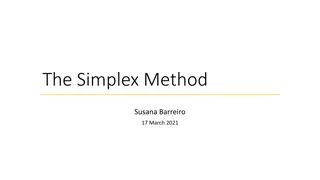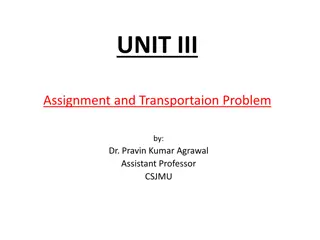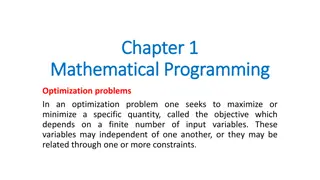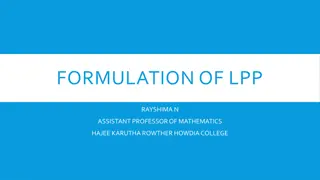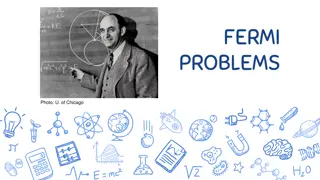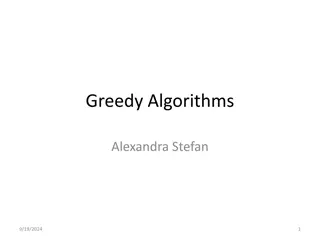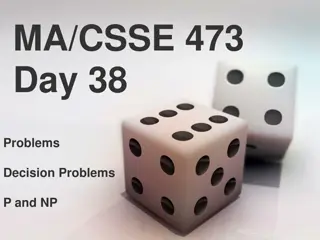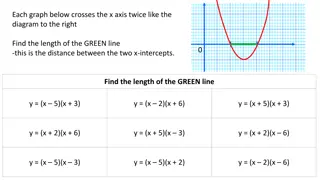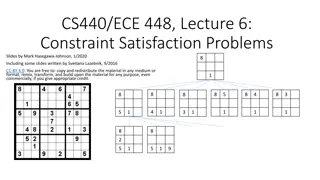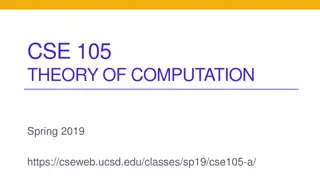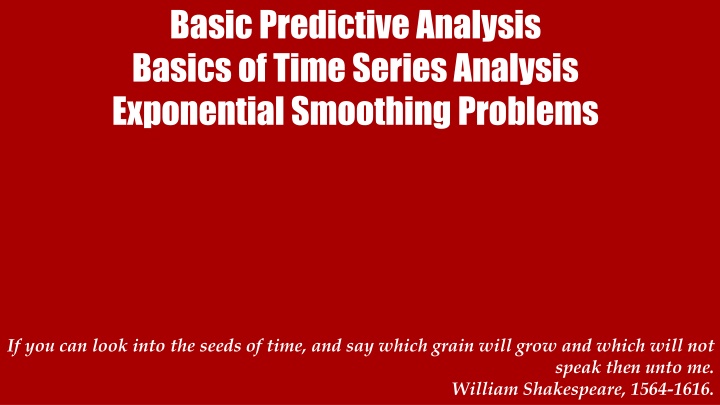
Mastering Exponential Smoothing Forecasting Techniques
Explore the principles of exponential smoothing in time series analysis through practical examples. Learn to forecast demand, optimize alpha values, and minimize errors using Excel. Enhance your predictive analysis skills with insights from renowned experts in the field.
Download Presentation

Please find below an Image/Link to download the presentation.
The content on the website is provided AS IS for your information and personal use only. It may not be sold, licensed, or shared on other websites without obtaining consent from the author. If you encounter any issues during the download, it is possible that the publisher has removed the file from their server.
You are allowed to download the files provided on this website for personal or commercial use, subject to the condition that they are used lawfully. All files are the property of their respective owners.
The content on the website is provided AS IS for your information and personal use only. It may not be sold, licensed, or shared on other websites without obtaining consent from the author.
E N D
Presentation Transcript
Basic Predictive Analysis Basics of Time Series Analysis Exponential Smoothing Problems If you can look into the seeds of time, and say which grain will grow and which will not speak then unto me. William Shakespeare, 1564-1616.
The Lecture https://youtu.be/1J6ysRf75K0 The Lecture https://youtu.be/g_lg0F_7Hmc Exponential Smoothing Problems, A. Asef-Vaziri, Systems & Operations Management. 2
Exponential Smoothing- Two Formulas That are the same = ( + ) F F A F + 1 t t t t = + F F A F + 1 t t t t = ) + 1 ( F F A + 1 t t t Exponential Smoothing Problems, A. Asef-Vaziri, Systems & Operations Management. 3
From This Period to the Next Period 1. Given an actual demand of 60 for a period when forecast of 70 was anticipated, and an alpha of 0.3, what would the forecast for the next period be using simple exponential smoothing? F = (1-0.3)(70)+0.3(60) = 67 2. You have been asked to forecast demand for a product using an exponential smoothing. The actual demand and forecast for year 2019 where 850 and 910, respectively. Compute the demand forecast for 2020 using a smoothing constant of 0.3. F = (1-0.3)(910)+0.3(850) = 892 3. Given the following demand. What is your forecast for period 4 using exponential smoothing and =0.5? 1:(300), 2:(500), 3:(600). Ft+1 = (1- )Ft+ (At) Ft+1 = (1-0.5)Ft+ 0.5(At) Ft+1 = (1/2) Ft+ (1/2) (At) Ft+1 = (Ft+At)/2 F3 = (F2+A2)/2 F3 = (300+500)/2= 400 F4 = (F3+A3)/2 = (400+600)/2 = 500 Exponential Smoothing Problems, A. Asef-Vaziri, Systems & Operations Management. 4
Large or Small, 0.1, 0.2, 0.4 4. Is large better or small ? Forecast 350 300 We do not know. It depends on data. 250 200 The best is the one that minimizes our metric which may be MAD or MSE or MARD. 150 100 50 0 0 1 2 3 4 5 6 7 8 9 Actual alpha=0.1 alpha=0.4 Week 1 2 3 4 5 6 7 8 Demand 200 250 175 186 225 285 305 190 Forecast 200 200 205 202 200.4 202.9 211.1 220.5 =0.1 Ft for = 200 0.2 Ft for = 0.4 200 200.00 220.00 202.00 195.60 207.36 238.42 265.05 =B2 =(1-$E$1)*C2+$E$1*B2 200.00 =(1-$E$1)*C3+$E$1*B3 210.00 =(1-$E$1)*C4+$E$1*B4 203.00 =(1-$E$1)*C5+$E$1*B5 199.60 =(1-$E$1)*C6+$E$1*B6 204.68 =(1-$E$1)*C7+$E$1*B7 220.74 =(1-$E$1)*C8+$E$1*B8 237.60 Exponential Smoothing Problems, A. Asef-Vaziri, Systems & Operations Management. 5
MAD in Excel 5. The president of State University wants to forecast student enrollments for the next academic year based on the following historical data for the past 5 years. What is your forecast for next year using exponential smoothing with = 0.4? = At 0.4 Ft t 1 2 3 4 5 |E| 0 MAD 0 500 1200 1790 2059.2 15000 16000 18000 20000 21000 15000 15000 =(1-$C$1)*C3+$C$1*B3 1000 15400 =(1-$C$1)*C4+$C$1*B4 2600 16440 =(1-$C$1)*C5+$C$1*B5 3560 17864 =(1-$C$1)*C6+$C$1*B6 3136 19118.4=(1-$C$1)*C7+$C$1*B7 2574 =B3 Forecast Mean Forecast StdDev 19118 2574 Exponential Smoothing Problems, A. Asef-Vaziri, Systems & Operations Management. 6
Role of 6. A forecast based on the previous forecast plus a percentage of the forecast error is: A) a naive forecast B) a simple moving average forecast C) a centered moving average forecast D) an exponentially smoothed forecast E) an associative forecast Ft+1 = (1- )Ft+ (At) Ft+1 = Ft+ (At-Ft ) 7. In exponential smoothing forecasting, using large values of the smoothing coefficient generates forecasts that are more: A) accurate B) responsive C) random D) stable E) level Ft+1 = (1- )Ft+ (At) Exponential Smoothing Problems, A. Asef-Vaziri, Systems & Operations Management. 7
Meaning of - From Nave to No Change 8. For what value of , exponential smoothing becomes na ve method? A) =0 B) =0.25 C) =0.5 D) =0.75 E) =1 Ft+1 = (1- )Ft+ (At) Ft+1 = (At) Ft+1 = (1-1)Ft+ 1(At) 9. For what value of , exponential smoothing becomes a straight line? A) =0 B) =0.25 C) =0.5 D) =0.75 E) =1 Ft+1 = (1- )Ft+ (At) Ft+1 = Ft Ft+1 = (1-0)Ft+ 0(At) Exponential Smoothing Problems, A. Asef-Vaziri, Systems & Operations Management. 8
Change Alpha Value from 1 to 0 by 0.1 steps Year 1997 1998 1999 2000 2001 2002 2003 2004 2005 2006 2007 2008 2009 2010 2011 2012 2013 2014 2015 2016 2017 2018 2019 At Ft 1 Change alpha from 1 to 0 by step of .1 6464 7475 8237 9480 11642 11705 11837 13101 14194 15760 15667 14338 11816 14095 14001 14123 14599 15160 15352 15631 16887 17549 17090 6464 6464 7475 8237 9480 11642 11705 11837 13101 14194 15760 15667 14338 11816 14095 14001 14123 14599 15160 15352 15631 16887 17549 20000 18000 16000 14000 12000 10000 8000 6000 4000 2000 0 1995 2000 2005 2010 2015 2020 2025 Exponential Smoothing Problems, A. Asef-Vaziri, Systems & Operations Management. 9
Finding 10. Exponential smoothing is being used to forecast demand. The current forecast of 66 was 5 units larger than actual demand. The next forecast is 65. Compute ? F(t+1) = Ft + (At-Ft) 66 65 +5 - 5 65 = 66 + (-5) 5 = 1 = 0.2 11. It can be mathematically proved that the Age of data in exponential smoothing is 1/ . The larger the , the larger the number of periods in the moving average. True or false? Why? False = 0.5 age of data is 2 periods. = 0.2 age of data is 5 periods. = 0.1 age of data is 10 periods. Exponential Smoothing Problems, A. Asef-Vaziri, Systems & Operations Management. 10
Age of Data 12. Given a forecast using a 6 period moving average. What is the average age of data? The last piece (newest piece) of data is only 1 period old. The first piece (oldest piece) of data in a 6 period moving average is 6 periods old. The average age of data is (1+6)/2 = 3.5 13. If the age of data in exponential smoothing is 1/ , for what value of , exponential smoothing performs close to a six period moving average? The age of data in a 6 period moving average is 3.5. The age of data in exponential smoothing is 1/ . 1/ = 3.5 = 1/3.5 = 0.29 Exponential Smoothing Problems, A. Asef-Vaziri, Systems & Operations Management. 11


